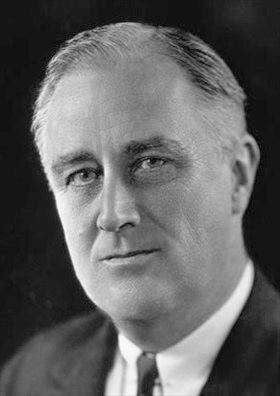ROOSEVELT, FRANKLIN D. (1882–1945)

Roosevelt was elected president in 1933, the year Adolf Hitler became Chancellor of Germany. Roosevelt had served as Assistance Secretary of the Navy during Woodrow Wilson’s presidency. After contracting polio in 1921 he fought to resume his political career in his native New York State and was elected governor in 1928. In 1932 he was the Democratic nominee for U.S. President.
Late in second term in office (1937–1941), Roosevelt persuaded the country to embrace military preparedness in the face of threats to world peace posed by Nazi Germany and Imperial Japan, made all the more necessary after the outbreak of war between Germany and Great Britain. In September 1940, he persuaded Congress to pass the Selective Service Act, the first peacetime conscription in the country’s history. After his election to a third term (1941–1945), Roosevelt signed the Lend-Lease Act in March 1941 to provide weapons and financial help to Britain and other Allied nations and in August off the coast of Newfoundland, Canada, he and British Prime Minister Winston Churchill signed the Atlantic Charter, which proclaimed their vision for a postwar world and committed like-minded nations to commit to destroying Nazi Germany. They met again in December 1941 at the White House.
After the Japanese sneak attack the U.S. Pacific Fleet anchored at Pearl Harbor on December 7, 1941, Roosevelt delivered his “This Date Shall Live in Infamy Speech” to the U.S. Congress, which declared war on Japan on December 8. War with Germany and its Axis allies followed several days later.
In 1942 Roosevelt ordered the internment of over 100,000 Japanese American civilians. In 1943 Roosevelt met with Allied leaders in high-profile conferences at various locations to plan war strategies: in Casablanca, where Roosevelt and Churchill announced that World War II would end only with Germany’s unconditional surrender; in Quebec, where the two Allied leaders and their joint chiefs of staff settled on plans for the invasion of Nazi-occupied Europe; in Cairo, where Roosevelt, Churchill, and Chinese Nationalist leader Chiang Kai-shek discussed strategy removing Japan from its Far East conquests; and in Tehran, where the two Western leaders, meeting with Soviet leader Joseph Stalin, committed their countries to opening a second front against Nazi Germany.
When the “Big Three” met in February 1945 in Yalta to plan the political shape of postwar Europe, Roosevelt’s exhaustion and advanced arteriosclerosis was obvious—yet American voters had elected the ailing president in a landslide victory to an unprecedented fourth term just three months earlier.
On April 12, 1945, Roosevelt suffered a massive cerebral hemorrhage in Warm Springs, Georgia, three weeks before the end of the war in Europe. He was succeeded in office by his vice-president, Harry S. Truman, who brought the global war to an end by ordering the atomic destruction of two Japanese cities, Hiroshima and Nagasaki.
![]()
President Franklin D. Roosevelt Before a Joint Session of the U.S. Congress, December 8, 1941
![]()

 History buffs, there is good news! The Daily Chronicles of World War II is now available as an ebook for $4.99 on Amazon.com. Containing a year’s worth of dated entries from this website, the ebook brings the story of this tumultuous era to life in a compelling, authoritative, and succinct manner. Featuring inventive navigation aids, the ebook enables readers to instantly move forward or backward by month and date to different dated entries. Simple and elegant! Click
History buffs, there is good news! The Daily Chronicles of World War II is now available as an ebook for $4.99 on Amazon.com. Containing a year’s worth of dated entries from this website, the ebook brings the story of this tumultuous era to life in a compelling, authoritative, and succinct manner. Featuring inventive navigation aids, the ebook enables readers to instantly move forward or backward by month and date to different dated entries. Simple and elegant! Click 











